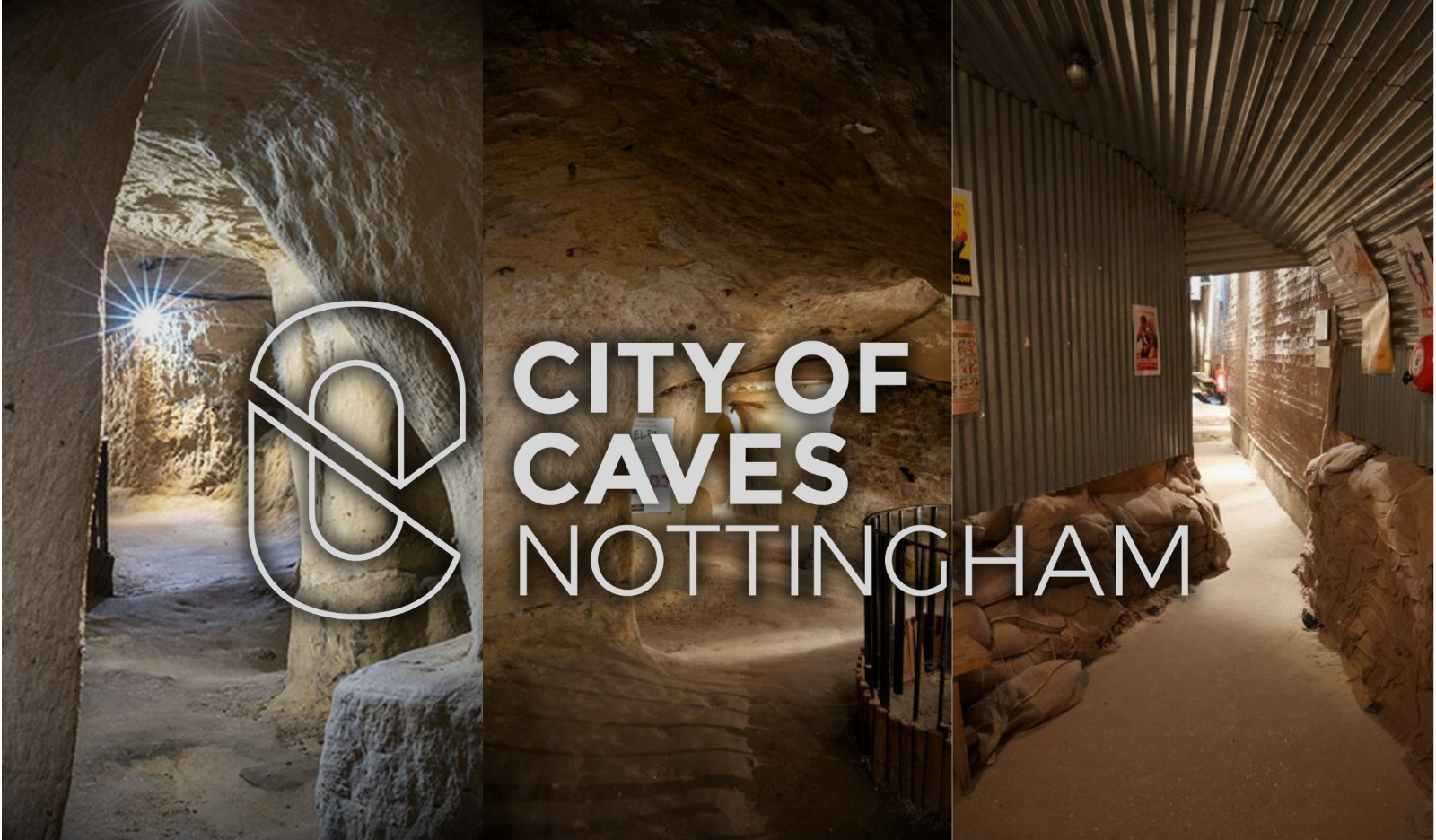Sometimes the most captivating features of a place are not those which stand out immediately, and you have to delve a little deeper to discover the best secrets. Of any city in Britain, this is perhaps most true of Nottingham and its vast underground network of caves.
Under our city streets lies a subterranean world full of stories, history and intrigue - but it is only in the past few decades that they have been given the spotlight for exploration. Owing to the sandstone foundations under our feet, from its emergence as a settlement in the 7th century, Nottingham earned the name Tigguo Cobauc, meaning Place of Caves in Old Brythonic. Ripe for the making of tunnels, the soft rock was carved away to create countless man-made caves and passages which through the centuries have been used as homes, storerooms, dungeons, tanneries, hideouts, and dozens of other uses. Today over 850 caves have been mapped out under the streets of our city, some accessible and others lost to the city’s development.
CITY OF CAVES

Nottingham’s prime destination to learn about the cave system is of course at City of Caves, which is a great experience for families or those new to the city. Along with detailing the history of the Broadmarsh and Lace Market area, you can hear about the many purposes of the caves, including their industrial, domestic, and more illicit uses, have a proper explore and discover how the system was first built and evolved throughout the centuries. Audio tours are available throughout the day, or if you fancy a more in-depth experience book onto a guided performance tour with Archie and Annie the archaeologists!
Don't forget, you can get more Nottingham history for your money with a joint ticket available for City of Caves and The National Justice Museum! Details are available here.
THE NATIONAL JUSTICE MUSEUM

One of Nottingham’s most extraordinary historical haunts is the National Justice Museum, the city’s old gaol and courts which date back to the 15th century. Also known as Shire Hall, the museum features a number of permanent and temporary exhibitions detailing the history of crime and punishment throughout the centuries. Feel the fear of thousands before you as you descend into the depths of the prison to explore the cells beneath – many of which are housed in the caves! - and hear the stories of the condemned. Medieval banquets, dramatic trials and murder mystery nights are just some of the events that take place, along with an excellent educational programme for schools.
Don't forget, you can get more Nottingham history for your money with a joint ticket available for City of Caves and The National Justice Museum! Details are available here.
BREWHOUSE YARD
.jpeg)
Nestled under the rock on which Nottingham Castle is built, Brewhouse Yard is made up of five 17th century cottages containing caves burrowed deep into the sandstone. During their time the caves at Brewhouse Yard have had many uses, from plague houses in the 14th century, air raid shelters during WWII, and even a lab for testing cosmic rays in the 1970s! For many years the area was used as the castle’s main brewhouse, and the legendary pub Ye Olde Trip to Jerusalem is also located here. Today the cottages contain The Museum of Nottingham Life, which documents the history of the city through a mixture of reconstructed rooms & shop settings, gallery displays and artefacts.
MORTIMER'S HOLE

Having been destroyed and rebuilt several times over the past 8 centuries, Nottingham Castle sadly no longer resembles the medieval fortress it once was. However, if you’re looking for that lovely ancient timeworn aesthetic, it is the rock on which the castle stands that will tickle your fancy. Like much of the city, the sandstone foundations beneath our streets have been carved out to create secret tunnels, and these are stories indeed well preserved! The most extensive tunnel, Mortimer’s Hole, was named after usurper to the throne Sir Roger Mortimer, who was captured in the night and dragged to his death by King Edward III’s men. Tours of the Castle caves happen daily so we won't mention anymore, but this is an attraction you can’t visit Nottingham without seeing!
YE OLDE TRIP TO JERUSALEM
Ye Olde Trip To Jerusalem is one of the country’s oldest inns and another staple spot on Nottingham’s ‘Must See’ list. This legendary pub is known throughout the country - but don’t expect a tacky tourist trap when you arrive. Despite its wide reputation, the ‘Trip is mostly frequented by locals wanting a pint of crisp Nottingham ale and a friendly atmosphere. Built into the cliffside, with caves running underneath making up the majority of it's cellars. The pub consists of several cosy rooms and nooks carved right out of the rock, filled with antiques and ornaments such as the ‘Cursed Galleon’.
PEEL STREET CAVES
 The largest underground space in the city, the caves beneath Peel Street began their existence as a sand mine in the 18th century, providing sand to the nearby glass kiln factories. This vast and labyrinthine space, snaking far under Mansfield Road, is so immense that many have been lost in its depths for hours at a time, and rescue services have also used the space for drills and practices. Like many of Nottingham’s caves, during WWII the space was used as an air raid shelter, accommodating over 200 citizens at a time.
The largest underground space in the city, the caves beneath Peel Street began their existence as a sand mine in the 18th century, providing sand to the nearby glass kiln factories. This vast and labyrinthine space, snaking far under Mansfield Road, is so immense that many have been lost in its depths for hours at a time, and rescue services have also used the space for drills and practices. Like many of Nottingham’s caves, during WWII the space was used as an air raid shelter, accommodating over 200 citizens at a time.
It was not until the late 19th century that the then forgotten mine became a tourist attraction. Rebranded as the Robin Hood Mammoth Cave, access was available with a guide and during the subsequent decades many fanciful stories of the cave’s history were fabricated to amuse tourists, including tales of cavemen, druids, and dinosaurs.
THE MALT CROSS

The Malt Cross not only boasts the splendour of Victorian architecture, but beneath its floors lie long forgotten caves, now converted into a most unique space to host poetry nights, gin tastings and other events! Builders renovating the caves for public access in 2014 discovered fake walls, a concealed room, and a secret passage leading to an 800-year-old cave. Thought to be connected to nearby caves of a medieval Carmelite monastery, the spaces were once used for storage of beer.
The Malt Cross’s rich history as a music hall is reflected in its unique architecture, which features iron pillars, a mezzanine balcony level, and arched glass ceiling said to be held together by glue!
PARK ESTATE CAVES

Deep in Nottingham’s prestigious Park Estate, near the castle, lies perhaps Nottingham’s most elaborate cave and a work of art sadly unseen by most inhabitants of the city. Built under the instruction of one Alderman Thomas Herbert, these treasures were initially built as stone follies, intended to show off the wealth and taste of this wealthy 19th century landowner. Dating back over 150 years, the tunnels featured unusual scenes etched into the rock, including pictorial carvings of the Bible story Daniel in the Lion’s Den, exotic plants, sphinxes and other unusual creatures. While the tunnels are not open for public viewing, the nearby Park Tunnel is another example of tunnelling within the area.
CRESWELL CRAGS
 If you're visiting Welbeck, a quick hop over the road to Creswell Crags really is a must! Take a walk around the serene and atmospheric lake to explore this extraordinary limestone gauge, pocketed with curious caves set within the craggy cliffs. The site was one of the most northerly places visited by Ice Age man and was integral in teaching us about this significant period of human evolution during the most harsh of conditions. Hyena, woolly rhinoceros and mammoth remains have been found in the area, along with early tools. Within the heritage centre you can gain access to the craggy caves, hear more about Life in the Ice Age and see the UK’s only Ice Age rock art, which dates back an incredible 13,000 years!
If you're visiting Welbeck, a quick hop over the road to Creswell Crags really is a must! Take a walk around the serene and atmospheric lake to explore this extraordinary limestone gauge, pocketed with curious caves set within the craggy cliffs. The site was one of the most northerly places visited by Ice Age man and was integral in teaching us about this significant period of human evolution during the most harsh of conditions. Hyena, woolly rhinoceros and mammoth remains have been found in the area, along with early tools. Within the heritage centre you can gain access to the craggy caves, hear more about Life in the Ice Age and see the UK’s only Ice Age rock art, which dates back an incredible 13,000 years!
Related
Comments
Comments are disabled for this post.

 to add an item to your Itinerary basket.
to add an item to your Itinerary basket.












